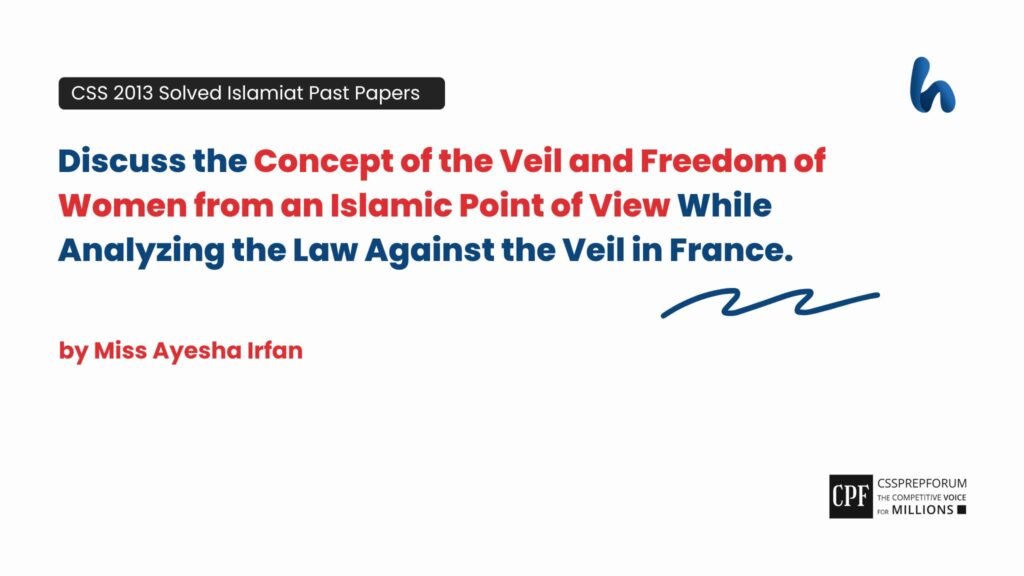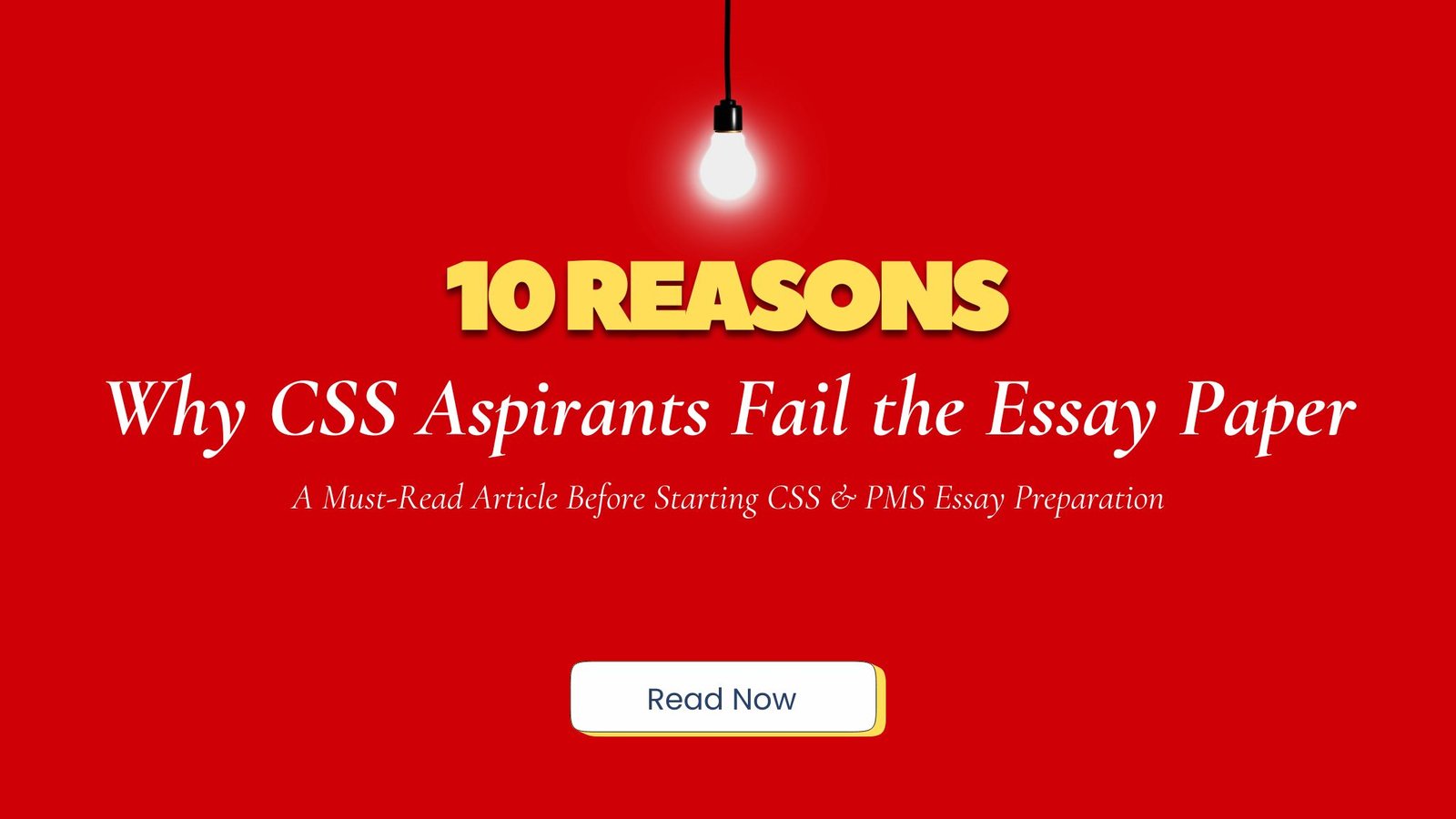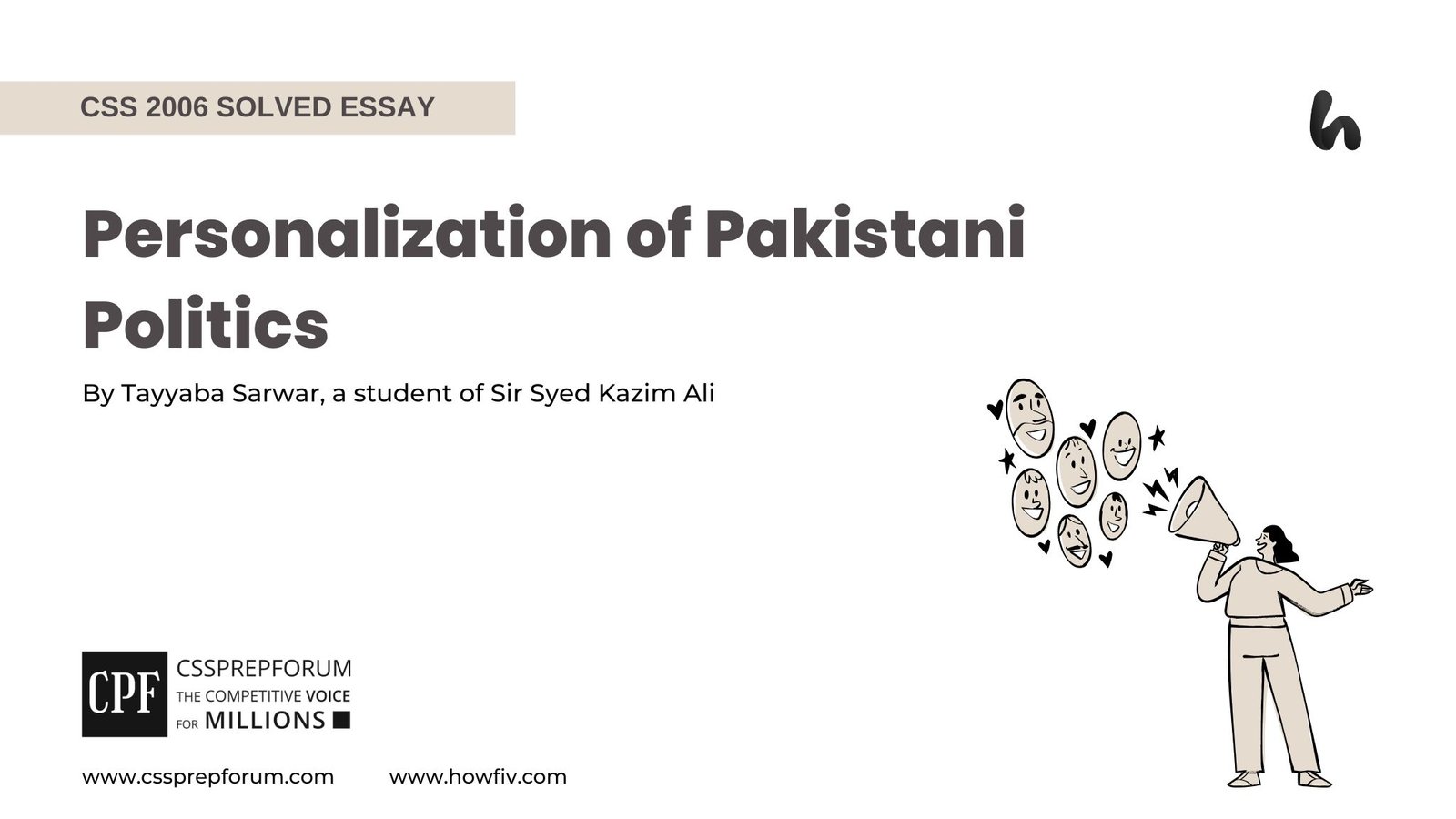CSS 2013 Solved Islamiyat Past Papers | The Concept of the Veil and Freedom of Women
The following question of CSS Islamiat 2013 is solved by Miss Ayesha Irfan, the highest scorer in CSS Islamiat. Moreover, the question is attempted using the same pattern taught by Sir Syed Kazim Ali to his students, who have scored the highest marks in compulsory subjects for years. This solved past paper question is uploaded to help aspirants understand how to crack a topic or question, write relevantly, what coherence is, and how to include and connect ideas, opinions, and suggestions to score the maximum.

Question Breakdown
The examiner asked to explain the concept of the veil and women’s freedom from an Islamic point of view while analyzing the law against the veil in France. First, you should explain the importance of the veil and freedom of women from an Islamic point of view, then Give details on the concept of the veil and freedom of women from an Islamic point of view while analyzing the law against the veil in France.
Outline
1-Introduction
2- Importance of the Islamic Perspective on Veil and Women’s Freedom
- ✓ The concept of Hijab in the Quran and Hadith
- ✓ Purpose of the veil: Modesty, dignity, and protection
- ✓ Freedom in Islam: Women’s rights and autonomy
3-Legal Restrictions on Veil in France
- ✓ Overview of the French laws against the veil (2004 ban on hijab in schools, 2010 ban on face coverings in public)
- ✓ Impact on Muslim women: Restriction or empowerment?
4- An Analysis of Legal Restrictions on Veil in France (Freedom vs. Restriction)
- ✓ Does banning the veil promote or restrict freedom?
- ✓ The contradiction in advocating freedom while restricting religious expression
5-Critical analysis
6- Conclusion

Answer to the Question
Introduction
In Islam, the hijab, or veil, is a significant symbol of identity, religion, and dignity that goes beyond simply being a piece of clothing. Based on the ideas of humility, it shows more incredible dedication to moral and spiritual beliefs than just outward appearance. According to Islamic beliefs, modesty encompasses more than just clothing; it also includes behaviours, words, and relationships, promoting a community based on decency and respect. Nonetheless, the idea of the veil is frequently discussed in relation to religious duty and individual freedom. Islam maintains the idea of free will. Therefore, faith is not imposed but rather remains a conscious and individual choice, even though it encourages women to wear the hijab as a sign of commitment. The discourse around the veil is shaped by this difficult balance between religious observance and personal autonomy, especially in settings where its use is banned or contested.
Importance of the Islamic Perspective on the Veil and Women’s Freedom
- The concept of Hijab in the Quran and Hadith
In Islam, the hijab is a way of life that encourages modesty, dignity, and respect for both men and women. It has its roots in the Quran and Sunnah and includes not just physical clothing but also relationships, speech, and behaviour. According to the Surah An-Nur ayahs 30-31, “And tell the believing women to lower their gaze and guard their chastity, and not to reveal their adornments except what normally appears. Let them draw their veils over their chests, and not reveal their ˹hidden˺ adornments except to their husbands, their fathers, their fathers-in-law, their sons, their stepsons, their brothers, their brothers’ sons or sisters’ sons, their fellow women, those ˹bondwomen˺ in their possession, male attendants with no desire, or children who are still unaware of women’s nakedness. Let them not stomp their feet, drawing attention to their hidden adornments. Turn to Allah in repentance altogether, O believers, so that you may be successful”. Additionally, he counselled Asma bint Abi Bakr (RA) that a woman should cover her whole body save for her hands and face once she reaches adulthood (Abu Dawood 4104). In order to promote a society based on moral integrity and respect for one another, the hijab is, therefore, more than just a piece of clothing; it is also a means of developing humility, self-respect, and a sense of God.
- Purpose of the veil: Modesty, dignity, and protection
Islam’s profound spiritual and social philosophy is reflected in the veil’s functions of modesty, dignity, and protection. As instructed in the Quran, “Tell the believing women to lower their gaze and guard their chastity, and not to reveal their adornments except what normally appears” (An-Nur Surah 24:31). It maintains modesty by preventing objectification and encouraging self-respect. By upholding a woman’s right to be respected for her character rather than her looks, it guarantees dignity. As a result, the veil is more than simply a piece of cloth; it is a symbol of faith, empowerment, and safety.
- Freedom in Islam: Women’s rights and autonomy
Islam gives women autonomy and rights, guaranteeing them independence in decision-making, employment, ownership, and education. According to the Quran, “And for women is a share of what they have earned, and for men is a share of what they have earned.” This reinforces their autonomy. (An-Nisa Surah 4:32). According to the Prophet PBUH, “A woman who has been previously married should not be married until she is consulted, and a virgin should not be married until her consent is sought.” Islam also protects their right to consent in marriage. (Bukhari’s Sahih). Thus, the preceding principles highlight how Islam respects women’s autonomy, freedom, and dignity within a moral framework rather than oppressing them.
Explaining the Legal Restrictions on Veil in France
- Overview of the French laws against the veil (2004 ban on hijab in schools, 2010 ban on face coverings in public)
France has put legislative limitations on the veil, citing national identity and secularism. Hijabs and other religious symbols were prohibited in public schools in 2004 by the government, which claimed that they went against the laïcité (state secularism) ideal. France was the first European nation to outlaw full-face veils, such as the burqa and niqab, in public areas in 2010. Violations of this law were punishable by penalties. The ordinance has drawn a lot of criticism for discriminating against Muslim women and limiting their freedom of religion despite being justified on the basis of social integration and public safety. These actions are a reflection of the continuous conflict in France between state-imposed secularism and individual liberty.
- Impact on Muslim women: Restriction or empowerment
France’s legislative prohibitions have significantly impacted Muslim women on veiling, and there is evidence that these regulations are more restrictive than empowering. According to a survey by the Open Society Justice Initiative, most impacted women decreased their public activities following the 2010 ban on full-face veils, including necessary activities like shopping and dropping their kids off at school, which resulted in a rise in social isolation. (CAMBRIDGE UNIVERSITY PRESS & ASSESSMENT). Furthermore, 94% of victims of physical and verbal abuse directed at Muslims are women, according to the Collective Against Islamophobia in France, suggesting that vulnerability has increased since the ban. According to these figures, Muslim women have experienced increased marginalization and fear as a result of the veil bans, casting doubt on the idea that such laws foster female empowerment.
An Analysis of Legal Restrictions on Veil in France: Freedom vs. Restriction
- Does banning the veil promote or restrict freedom?
In addition to being rationalized as a way to advance social cohesiveness and gender equality, data suggests that veil bans may actually limit people’s liberties. Following France’s 2010 ban on full-face veils, many Muslim women reported feeling more socially isolated and harassed; some even stayed at home to avoid conflict, according to research by the Open Society Justice Initiative. Furthermore, these prohibitions have drawn criticism from Human Rights Watch for breaching Muslim women’s freedom of religion and speech by disproportionately harming them. These results imply that veil prohibitions may worsen social exclusion and violate individual rights rather than foster freedom.
- The contradiction in advocating freedom while restricting religious expression
There is a conflict between promoting freedom and limiting religious expression in France’s veil ban. The prohibition, which restricts Muslim women’s right to dress in accordance with their faith while purporting to advance gender equality, has drawn criticism from Human Rights Watch for unfairly targeting Muslim women. In addition, a 2020 Pew Research survey revealed that France has one of the strictest laws on religious clothing in Europe, which sparked worries about unfair treatment in the name of liberty. Such regulations isolate Muslim women rather than promote inclusion, making them choose between their faith and social engagement.
Critical Analysis
From an Islamic standpoint, women’s freedom is firmly anchored in the values of autonomy, dignity, and choice, particularly when it comes to issues of faith and individual identity. Contrary to ideas of oppression, many Muslim women regard the veil as powerful because it gives them the ability to influence how society perceives them and shifts attention from outward appearance to within attributes. This view is contradicted by the French law that forbids the hijab in public places, which restricts a woman’s freedom of expression about her cultural and religious identity. Therefore, the legislation violates women’s rights to autonomy, self-expression, and religious freedom, especially when it conflicts with Islamic teachings that value individual choice and respect for one’s beliefs.
Conclusion
In conclusion, from an Islamic perspective, women’s freedom is strongly linked to their ability to make decisions that are consistent with their identity, faith, and personal convictions, including whether or not to wear the hijab. This autonomy is undermined by the French law that forbids the veil in public institutions, which limits a woman’s ability to express her cultural identity and beliefs. The rule violates women’s rights to self-expression and religious freedom by enforcing a secular viewpoint that ignores the variety of personal reasons why people wear the veil. The French legislation against the veil illustrates the conflict between secularism and the basic right to personal freedom, and respect for individual choice is essential to guarantee that women’s rights are adequately safeguarded, especially in a multicultural society.

Searching for CSS or PMS Solved Islamiat Past Papers?
Are you preparing for CSS or PMS and searching for solved Islamiat past papers, notes, books, PDFs, and MCQs? Explore them for free on Howtests and Cssprepforum. All content is fully solved and written by Miss Ayesha Irfan. For your convenience, the links are provided below, simply click on any to start reading and preparing.












